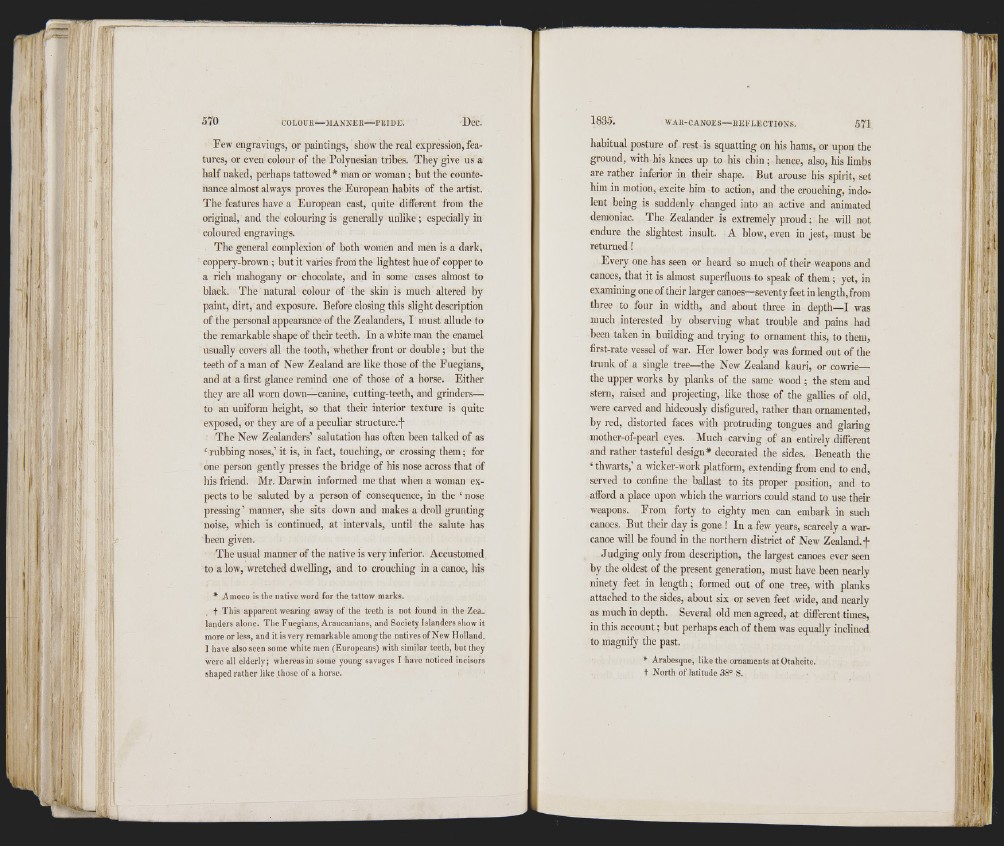
f 0 f M
570 COLOUR MANNER PRIDE. Dec.
Few engravings, or paintings, show the real expression, features,
or even colour of the Polynesian trihes. They give us a
half naked, perhaps tattowed* manor woman ; hut the countenance
almost always proves the European habits of the artist.
The features have a European cast, quite different from the
original, and the colouring is generally unlike; especially in
coloured engravings.
The general complexion of hoth women and men is a dark,
coppery-brown ; but it varies from the lightest hue of copper to
a rich mahogany or chocolate, and in some cases almost to
black. The natural colour of the skin is much altered by
paint, dirt, and exposure. Before closing this slight description
of the personal appearance of the Zealanders, I must allude to
the remarkable shape of their teeth. In a white man the enamel
usually covers all the tooth, whether front or double ; but the
teeth of a man of New Zealand are like those of the Fuegians,
and at a first glance remind one of those of a horse. Either
they are all worn down—canine, cutting-teeth, and grinders—
to an uniform height, so that their interior texture is quite
exposed, or they are of a peculiar structure.#
The New Zealanders’ salutation has often been talked of as
‘ rubbing noses,’ it is, in fact, touching, or crossing them; for
one person gently presses the bridge of his nose across that of
his friend. Mr. Darwin informed me that when a woman expects
to be saluted by a person of consequence, in the ‘ nose
pressing’ manner, she sits down and makes a droll grunting
noise, which is continued, at intervals, until the salute has
been given.
The usual manner of the native is very inferior. Accustomed
to a low, wretched dwelling, and to crouching in a canoe, his
* Amoco is the native word for the tattow marks.
t This apparent wearing away of the teeth is not found in the Zealanders
alone. The Fuegians, Araucanians, and Society Islanders show it
more or less, and it is very remarkable among the natives of New Holland.
I have also seen some white men (Europeans) with similar teeth, but they
were all elderly; whereas in some young savages I have noticed incisors
shaped rather like those of a horse.
1835. WAR-CANOES— EEELECTIONS. 571
habitual posture of rest is squatting on his hams, or upon the
ground, with his knees up to his chin; hence, also, his limbs
are rather inferior in their shape. But arouse his spirit, set
him in motion, excite him to action, and the crouching, indolent
being is suddenly changed into an active and animated
demoniac. The Zealander is extremely proud; he will not
endure the slightest insult. A blow, even in jest, must be
returned !
Every one has seen or heard so much of their weapons and
canoes, that it is almost superfluous to speak of them; yet, in
examining one of their larger canoes—seventy feet in length, from
three to four in width, and about three in depth—I was
much interested by observing what trouble and pains had
been taken in building and trying to ornament this, to them,
first-rate vessel of war. Her lower body was formed out of the
trunk of a single tree—the New Zealand kauri, or cowrie—
the upper works by planks of the same wood ; the stem and
stern, raised and projecting, like those of the gallies of old,
were carved and hideously disfigured, rather than ornamented,
by red, distorted faces with protruding tongues and glaring
mother-of-peai-1 eyes. Much carving of an entirely different
and rather tasteful design* decorated the sides. Beneath the
‘ thwarts,’ a wicker-work platform, extending from end to end,
served to confine the ballast to its proper position, and to
afford a place upon which the warriors could stand to use their
weapons. From forty to eighty men can embark in such
canoes. But their day is gone ! In a few years, scarcely a war-
canoe will be found in the northern district of New Zealand.#
Judging only from description, the largest canoes ever seen
by the oldest of the present generation, must have been nearly
ninety feet in length; formed out of one tree, with planks
attached to the sides, about six or seven feet wide, and nearly
as much in depth. Several old men agreed, at different times,
in this account; but perhaps each of them was equally inclined
to magnify the past.
* Arabesque, like the ornaments at Otaheite.
+ North of latitude 38° S.
■0 til
¡ i ' l
I
1!
Y
U'
f
" I /
I'l
<1